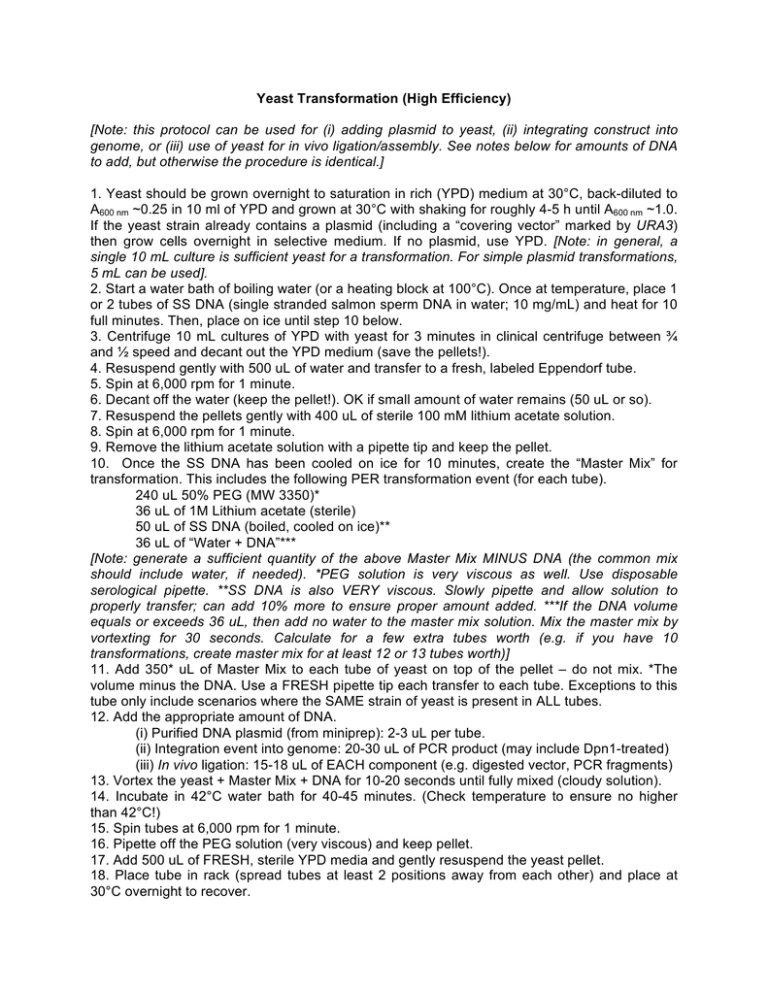Yeast Transformation (High Efficiency)
advertisement

Yeast Transformation (High Efficiency) [Note: this protocol can be used for (i) adding plasmid to yeast, (ii) integrating construct into genome, or (iii) use of yeast for in vivo ligation/assembly. See notes below for amounts of DNA to add, but otherwise the procedure is identical.] 1. Yeast should be grown overnight to saturation in rich (YPD) medium at 30°C, back-diluted to A600 nm ~0.25 in 10 ml of YPD and grown at 30°C with shaking for roughly 4-5 h until A600 nm ~1.0. If the yeast strain already contains a plasmid (including a “covering vector” marked by URA3) then grow cells overnight in selective medium. If no plasmid, use YPD. [Note: in general, a single 10 mL culture is sufficient yeast for a transformation. For simple plasmid transformations, 5 mL can be used]. 2. Start a water bath of boiling water (or a heating block at 100°C). Once at temperature, place 1 or 2 tubes of SS DNA (single stranded salmon sperm DNA in water; 10 mg/mL) and heat for 10 full minutes. Then, place on ice until step 10 below. 3. Centrifuge 10 mL cultures of YPD with yeast for 3 minutes in clinical centrifuge between ¾ and ½ speed and decant out the YPD medium (save the pellets!). 4. Resuspend gently with 500 uL of water and transfer to a fresh, labeled Eppendorf tube. 5. Spin at 6,000 rpm for 1 minute. 6. Decant off the water (keep the pellet!). OK if small amount of water remains (50 uL or so). 7. Resuspend the pellets gently with 400 uL of sterile 100 mM lithium acetate solution. 8. Spin at 6,000 rpm for 1 minute. 9. Remove the lithium acetate solution with a pipette tip and keep the pellet. 10. Once the SS DNA has been cooled on ice for 10 minutes, create the “Master Mix” for transformation. This includes the following PER transformation event (for each tube). 240 uL 50% PEG (MW 3350)* 36 uL of 1M Lithium acetate (sterile) 50 uL of SS DNA (boiled, cooled on ice)** 36 uL of “Water + DNA”*** [Note: generate a sufficient quantity of the above Master Mix MINUS DNA (the common mix should include water, if needed). *PEG solution is very viscous as well. Use disposable serological pipette. **SS DNA is also VERY viscous. Slowly pipette and allow solution to properly transfer; can add 10% more to ensure proper amount added. ***If the DNA volume equals or exceeds 36 uL, then add no water to the master mix solution. Mix the master mix by vortexting for 30 seconds. Calculate for a few extra tubes worth (e.g. if you have 10 transformations, create master mix for at least 12 or 13 tubes worth)] 11. Add 350* uL of Master Mix to each tube of yeast on top of the pellet – do not mix. *The volume minus the DNA. Use a FRESH pipette tip each transfer to each tube. Exceptions to this tube only include scenarios where the SAME strain of yeast is present in ALL tubes. 12. Add the appropriate amount of DNA. (i) Purified DNA plasmid (from miniprep): 2-3 uL per tube. (ii) Integration event into genome: 20-30 uL of PCR product (may include Dpn1-treated) (iii) In vivo ligation: 15-18 uL of EACH component (e.g. digested vector, PCR fragments) 13. Vortex the yeast + Master Mix + DNA for 10-20 seconds until fully mixed (cloudy solution). 14. Incubate in 42°C water bath for 40-45 minutes. (Check temperature to ensure no higher than 42°C!) 15. Spin tubes at 6,000 rpm for 1 minute. 16. Pipette off the PEG solution (very viscous) and keep pellet. 17. Add 500 uL of FRESH, sterile YPD media and gently resuspend the yeast pellet. 18. Place tube in rack (spread tubes at least 2 positions away from each other) and place at 30°C overnight to recover. 19. Take extreme care once the tube is opened—gasses build up in the tube and it may “pop” if you are not careful to open the tubes. Open and expel any gas build up. Close again, then vortex briefly (3-5 seconds). 20. Add the appropriate amount of yeast onto selective plates. Selection plates for yeast plasmid transformations may be “cut” into 2 or 3 or 4 smaller positions (use a razor blade to slide a small strip of agar out). 50-100 uL of the yeast + YPD solution should be carefully added to each position on the plate and carefully spread with a pipette tip, or with a sterile glass wand (alcohol, flame, dry each time). Be sure not to splatter or split any yeast onto other positions on the plate! (no cross-contamination!). For integrations of constructs into the genome, add 250500 uL of the yeast + YPD mixture onto a plate (may use ½ a plate) but ensure that part of the spreading is for single colonies. For in vivo ligations (IVLs), one can use an entire plate, or ½ a plate and place the entire volume (500 uL or so) of the yeast + YPD mixture and spread (no need for single colonies). Place the plates with the lids on top (since the liquid was just poured on the surface). After 1 day, flip the plate upside down. 21. Incubate at 30°C for 2 days. 22. Proceed with experiments…





